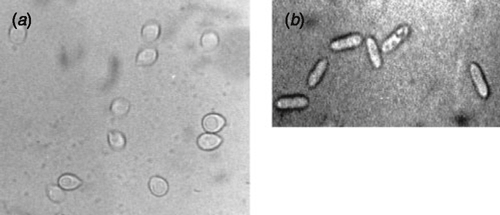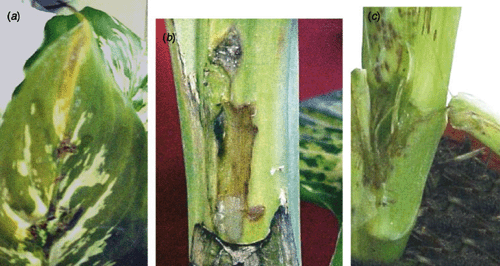First report of Fusarium moniliforme var. anthophylum affecting Dieffenbachia picta var. tropic in Buenos Aires, Argentina
H. E. Palmucci A C and D. Barreto BA Facultad de Agronomía, Universidad Nacional de Buenos Aires, Avenida San Martín 4453, (1416) Buenos Aires, Argentina.
B IMyZA, INTA, De los Reseros y las Cabañas, (1712) Castelar, Buenos Aires, Argentina.
C Corresponding author. Email: palmucci@agro.uba.ar
Australasian Plant Disease Notes 2(1) 17-18 https://doi.org/10.1071/DN07007
Submitted: 5 March 2006 Accepted: 15 January 2007 Published: 1 February 2007
Abstract
This is the first report of Fusarium moniliforme var. anthophyllum affecting foliage plants of Dieffenbacchia in Argentina. It appears to be the first report of the isolation and description of the causal agent of this disease on this host in the world.
The genus Dieffenbachia (Araceae) is an ornamental herbaceous plant native to Central and South America. The different varieties are mainly used in interior landscaping in Argentina. In the summer of 2002, commercial greenhouses of Dieffenbachia picta var. tropic located in the vicinity of Buenos Aires were affected by a new disease with low prevalence and high incidence. The symptoms included water-soaked lesions on leaves, petioles and stems. The lesions on the leaves were irregularly shaped, at first yellowish green and darkening, with reddish-purple borders extending up to 2 cm. The stems were affected after the leaves fell off. Water-soaked areas with dark margins extended along the stem.
Samples of affected tissue, 3–5 mm in diameter, from leaves, petioles and stems were surface disinfected by immersion in a 2% sodium hypochlorite for 2 min and then rinsed several times in sterile distilled water. The pieces of surface-sterilised tissue were placed on the surface of 2% potato dextrose agar (PDA) acidified to pH 6.5, and sucrose nutrient agar (SNA). Fungal cultures were maintained at 25 ± 2°C during the first 48 h and then placed under near ultraviolet light (Philips tubes TL 40/08) with a 12-h photoperiod at 22 ± 2°C. The isolated fungus was characterised after 10 days’ growth based on spore shape, size, septation and culture morphology. Pure cultures formed white farinose colonies with a light orange tint of the media. Abundant microconidia of three morphologic types were observed: allantoids with an average area of 8 × 2.4 μm (1-septated), 6.8 × 2.7 μm (0-septated) and 3 × 3 μm (round) (Fig. 1). Chlamydospores were not found. A few 3-septate macroconidia were found. Morphologic, biometrics and cultural characteristics allowed us to identify Fusarium moniliforme var. anthophilum (A. Braun) Wollenw as the cause (Booth 1977, Gerlach and Nirenberg 1982). The teleomorph was not observed. A culture of this pathogen is kept in the culture collection of the Agronomy Faculty (Buenos Aires).

|
Pathogenicity tests were carried out using conidia washed from 10-day-old cultures grown on SNA medium adjusted to 106 conidia/mL. Small wounds were applied to some plants with a sterile needle. Inoculum was applied until runoff onto D. picta var. tropic plants grown in pots. Inoculated plants were covered with polyethylene bags and maintained at 22 ± 2°C with 98% relative humidity in darkness for 48 h, returned to the greenhouse and maintained at 23 ± 2°C with a 12-h light/dark cycle (fluorescent light). Control plants were inoculated with sterile distilled water. Disease symptoms developed first in the wounded plants 4 days after inoculation (Fig. 2) and later in the uninjured inoculated plants. The fungus was reisolated from the inoculated plants. Control plants remained healthy.

|
F. moniliforme var. anthophylum was determined to be the causal agent of the water soaked lesions on D. picta var. tropic in greenhouses. The fungus may cause root rot, dry rot, crown rot, chlorosis, wilt and death of plants. Leaf spots are less frequent. A disease caused by Fusarium moniliforme and F. solani was reported in the plant genera Caladium, Chamadorea, Codiaeum, Dieffenbacchia, Disygotheca, Dracaena, and Saintpaulia. This it is the first report of F. moniliforme var. anthophyllum affecting foliage plants of Dieffenbacchia in Argentina.


